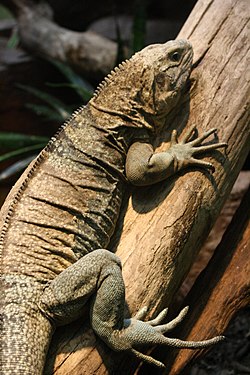Jamaican iguana
| Jamaican iguana | ||||||||||||
|---|---|---|---|---|---|---|---|---|---|---|---|---|

male Jamaican iguana |
||||||||||||
| Systematics | ||||||||||||
|
||||||||||||
| Scientific name | ||||||||||||
| Cyclura collei | ||||||||||||
| JE Gray , 1845 |
The 100 to 130 centimeters long Jamaican iguana ( Cyclura collei ) is one of the most threatened reptile species on earth. The total stock is only a few 100 copies.
Appearance
The head, neck and chest as well as the forelimbs are brown, the rest of the body is gray. The short, sharp thorns along the back line are brown on the neck and turn gray towards the back. The legs are strong and have long claws. The skin on the throat pouch and on the sides of the body is very wrinkled, the abdomen is not furrowed. The strong head is elongated and provided with individual larger thorny scales. The tail length is between 50 and 60 centimeters. As young animals, they have light and dark stripes for better camouflage from enemies.
Way of life
The animals spend most of their time on the ground, and occasionally they crawl on medium-high trees. At a young age, they mainly feed on insects. An adult specimen counts insects, small vertebrates such as bird chicks and also sweet fruits and fresh tree shoots as food. Older specimens prefer vegetarian food. They are mainly out and about in the early morning and evening hours and avoid the blazing midday heat. To cool off, they withdraw to the shade or allow themselves a cooling bath. To protect themselves from enemies, they hide in the rubble of the rocks, or they dig underground burrows with their sharp claws. The animal drives away its enemies with its powerful tail.
Reproduction
The female lays 2–6 eggs, which are provided with a tough leathery shell, in a self-dug hole in the ground. After about 50 days the young hatch and are immediately independent.
distribution
The Jamaican iguana is only found in Jamaica . This species inhabits the local mangrove forests.
Hazards and protective measures
The IUCN lists the Jamaican iguana in the critically endangered category of critically endangered . The reasons for this are the extremely small number of individuals (200–300) and the distribution in only two very limited natural locations. The cause is the stalking by domestic dogs, Indian mongooses and rats introduced by humans, as well as the destruction of the habitat for agricultural land, mining and hunting, as well as the collection of young animals for the pet trade. Between 1940 and 1990 this species was thought to be lost before it was rediscovered near Kingston . Several zoos in the United States are currently breeding in captivity to replenish the population.
Web links
- Cyclura collei in The Reptile Database
- Cyclura collei inthe IUCN 2016 Red List of Threatened Species . 3. Listed by: Grant, TD, Gibson, R. & Wilson, BS, 2010. Retrieved February 20, 2017.
literature
- The great world empire of the animals. Publisher: Planet Media AG, Zug 1992, pp. 432, 433, ISBN 3-8247-8614-1
- Miloš Anděra, German Translation by Günter Brehmer: Endangered animals. Publisher: Werner Dausien, Hanau 1998, pp. 151-154, ISBN 3-7684-2800-1
- Jiří Felix (ed.), Alena Čepická: America's fauna in color. Translated from the Czech by Jaroslav Konšal. Karl Müller Verlag, Erlangen 1989, p. 133
- Evžen Kůs, Václav Pfleger: Rare and threatened animals. The great color encyclopedia: Publisher: Gondrom 2000, S. 117, ISBN 3-8112-1830-1

